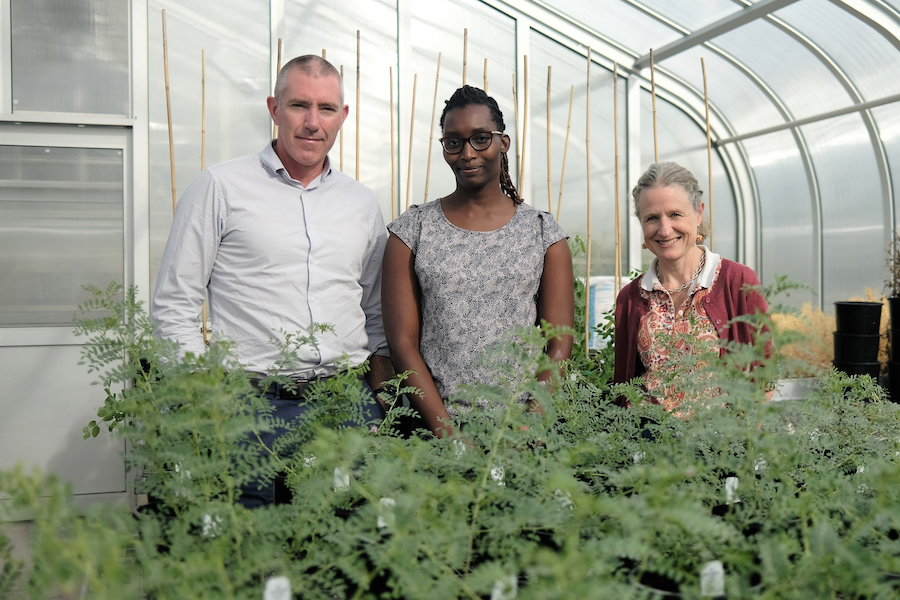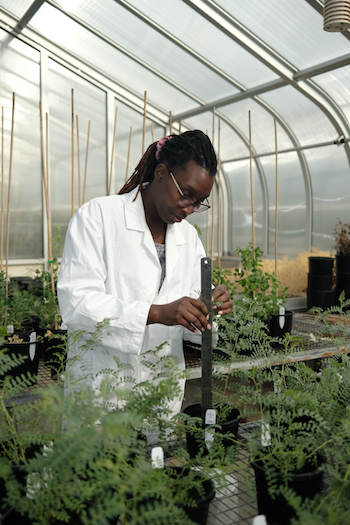Soil salinity is a global problem that limits crop production on 20 per cent of the world’s cultivated land and one-third of its irrigated land in more than 100 countries, including Australia.
And the salinity problem is worsening. Globally, the salt-affected area is said to be expanding at a rate of one to two million hectares a year.
In Australia, the National Land and Water Resources Audit has predicted the scale of the salinity problem will nearly treble from 5.7 to 17 million hectares by 2050.
Chickpea production is a major casualty, since the crop is particularly sensitive to salinity, and it is widely grown in salinity-prone, semi-arid areas. Salinity causes annual yield losses in global chickpea production estimated at eight to 10 per cent.
In Australia, researchers found that, on average, salinity reduced chickpea plant growth by 20 per cent, plant height by 15 per cent and shoot biomass by 28 per cent. Salinity also induced pod abortion and inhibited pod filling, which reduced chickpea seed number and seed yield by 16 and 32 per cent respectively.
Tackling the salinity problem facing Australian chickpea growers is an extensive collaborative research effort, with GRDC co-investment, spanning three consecutive projects from 2013–21.
Dr Tim Sutton, research director crop sciences at the South Australian Research and Development Institute (SARDI), was either chief investigator or project leader at different stages of the research.
He says the long-term study has provided a crucial lift in understanding the genetics of salinity tolerance in chickpeas.
The new understanding has enabled scientists to identify sections of DNA linked to genetic traits for salinity tolerance, known as quantitative trait loci (QTL).
“Crucially, the QTL identified were specifically linked to salinity tolerance, and they were also distinct from other more general plant characteristics that so often confound analysis of complex traits,” Dr Sutton says.
The QTL for salinity tolerance traits can be converted into genetic markers using Kompetitive allele specific PCR (KASP), a variant of the polymerase chain reaction (PCR) method used in molecular biology to copy specific DNA segments.
The KASP markers could then be used by Australian chickpea breeders in marker-assisted selection – a process that sees plant breeders select traits based on their link to markers.
Salinity-tolerant varieties

Dr Tim Sutton, Dr Judith Atieno (left) and Dr Julie Hayes were part of a nine-year voyage of discovery exploring the genetics and physiology of salinity tolerance in chickpeas. Photo: SARDI
“The improved understanding has culminated in plant breeding tools – genetic loci and associated markers – to guide the development of new salt-tolerant chickpea varieties,” Dr Sutton says.
“And, in turn, new salt-tolerant genetics could be part of a plant breeding package to expand the Australian chickpea crop into marginal, salinity-affected areas across Queensland, New South Wales, Western Australia, South Australia and Victoria.”
The release of salt-tolerant varieties can also help secure the crop’s foothold in areas predicted to become saline in the future.
Last year, for example, chickpeas were planted on about 607,000ha, mainly in Queensland and NSW. Plus, new salt-tolerant varieties could recast chickpeas as a resilient, rather than a sensitive, leguminous sequencing option in crop rotations for growers, Dr Sutton says.
Chasing these objectives, the research brought together a multidisciplinary team drawn from SARDI, the University of Adelaide, the University of Sydney, the University of Melbourne, Royal Melbourne Institute of Technology, the University of Western Australia (UWA) and the WA Department of Primary Industries and Regional Development (DPIRD).
Dr Rajeev Varshney at the International Crops Research Institute for the Semi-Arid Tropics (ICRISAT) in Patancheru, India, also led a project team.
Central to this collaboration was SARDI senior research officer Dr Judith Atieno, who Dr Sutton describes as the primary researcher for the experimental phase of each project.
Dr Atieno says the nine-year voyage of discovery exploring the genetics and physiology of salinity tolerance in chickpeas was slow, incremental and fraught with complexity.
Making advances in this field of science, called quantitative genetics, is notoriously tricky.
That is because the traits conferring salinity tolerance in are influenced by a chickpea plant's genetic make-up (genotype), developmental stage and environmental conditions.
So disentangling the genetic code for salinity tolerance from this web of influences, all of which interact, was no small feat.
Genetic diversity
Initial stages of the research examined genetic variation for salinity tolerance in diverse chickpea germplasm sourced from ICRISAT.
The focus of this early work, supported by the Australia-India Strategic Research Fund through the Department of Industry, Science, Energy and Resources with GRDC co-investment, was a collection of 245 chickpea accessions.
It contained old, locally adapted farmer varieties (landraces); ancient, wild crop relatives; commercial varieties and advanced breeding lines; and unclassified accessions.
Dr Atieno and the team analysed the collection using image-based phenotyping to measure plant growth rate under salinity in the Australian Plant Phenomics Facility at the University of Adelaide’s Waite campus.
Applying this high-throughput, high-resolution phenotyping technology to study salinity stress in chickpeas for the first time, scientists were able to more deeply explore the chickpea gene pool.
There, they found the chickpea germplasm contained significant genetic variation, meaning its allelic diversity could be mined for salinity-tolerance traits for use in chickpea breeding.
For instance, scientists found there was broad genetic variation for both salinity tolerance and different plant characteristics under salinity stress, such as growth rate, plant height, days to flowering, leaf senescence, shoot biomass, pod number, seed number and the sodium and potassium content in shoots.
It was a critical discovery as previous studies looking at limited numbers of chickpea genotypes suggested there was low genetic variation in the crop.
The genetic diversity discovered in chickpeas provided the foundation for further work to identify QTL and genetic markers for salinity tolerance.
To this end, the next stage of the research saw Dr Atieno and the team create a mapping population of 200 chickpea lines by crossing two Australian-adapted desi chickpea varieties.
They were assisted by UWA cell biologist Dr Janine Croser who provided the expertise to rapidly advance the mapping population.
Experimental population

Chickpeas being grown in trials at the Australian Plant Phenomics Facility. Photo: APPF
Scientists opted to cross the salinity-tolerant Genesis 836 and the salinity-sensitive Rupali varieties because the contrasting tolerance of these parental lines helped to set apart the genetic configuration of the sought-after tolerance traits.
Plus, the Genesis 836 variety has been extensively used as a primary source of salinity tolerance in the Australian chickpea breeding program.
The mapping population of chickpea lines was then put to the test in different experimental conditions: glasshouse, hydroponic and field trials.
Two years of field trials at the DPIRD research station at Merredin, WA, were an important component of the trial program.
This is because salinity tolerance is strongly influenced by environmental factors such as soil type and seasonal conditions where the crop is grown.
The trials in 2017 and 2018 were led by UWA senior deputy vice-chancellor Professor Tim Colmer with assistance from DPIRD and agricultural research consultancy Living Farm.
In parallel, scientists used high-throughput, image-based phenotyping in glasshouse experiments to measure the observable traits or phenotypic characteristics of each plant in the population.
“The aim was to study the impact of salinity on key plant physiological processes.
“It was the first study of salinity tolerance in chickpeas to use multi-environment experiments, including hydroponic trials, field trials and high-throughput, image-based phenotyping in glasshouse trials,” Dr Atieno says.
The traits examined by scientists related to yield such as number of filled pods and number of seeds, and development such as plant height and vegetative biomass.
Dr Atieno says analysis of the phenotypic data allowed scientists to separate the genetic effects specifically related to salinity tolerance from other physiological traits known to affect crop growth and flowering.
Genetic make-up explored
 Dr Judith Atieno measured the observable traits or phenotypic characteristics of chickpeas. Photo: SARDI
Dr Judith Atieno measured the observable traits or phenotypic characteristics of chickpeas. Photo: SARDI
In the next phase of the research, scientists used genotyping to detect small genetic differences that can lead to major differences in a plant’s phenotype, such as physiological differences that confer salinity tolerance.
Genotyping is the process of determining the DNA sequence or genetic make-up (genotype) of a plant. DNA sequences of individual plants are then compared to distinguish the alleles (gene variants) a plant line has inherited from its parents.
Phenotypic data generated in the study was then linked to the genotypic data for each plant in the mapping population to identify QTL or DNA sections that contain tolerance traits.
“We found three main QTL, otherwise known as genetic loci, and also identified molecular markers that are linked to the genomic regions that control salt tolerance in our mapping population,” Dr Atieno says.
The research has also identified plant characteristics that can help chickpea breeders narrow down the search for salinity tolerant lines, she says.
For example, scientists found leaf necrosis, which causes whitening and death of chickpea foliage, was the main indicator of salinity sensitivity.
In the past three years, University of Adelaide research associate Dr Julie Hayes has worked closely with Dr Atieno in exploring the genetics and physiology of salt tolerance, and how they relate to other developmental traits such as crop vigour.
This work, from 2019–21, was supported by the Australian Research Council (ARC) Research Hub for Legumes for Sustainable Agriculture with GRDC co-investment.
Dr Hayes adds that the new genetic markers would only be suitable to select for salinity-tolerance traits where the Genesis 836 variety is used as a parent line to develop new chickpea lines and, ultimately, varieties in breeding programs.
“We don’t know at this stage whether the genetic markers are applicable to other varietal sources of salt tolerance,” Dr Hayes says.
Flowering knowledge-lift
She says the mapping population, derived from crossing the Genesis 836 and Rupali varieties, has also contributed to new genetic understanding of flowering time in chickpeas.
“We have developed near-isogenic plant material, which are pairs of chickpea lines that are almost genetically identical, with the exception, in this case, of a genetic region that controls flowering.”
This genetic material is being evaluated by SARDI crop ecophysiologists Dr Lachlan Lake and Dr Victor Sadras to determine how flowering time affects yield in field trials this season.
Jim Weller, Associate Professor in plant genetics and ARC Future Fellow at University of Tasmania, is leading the pulse phenology research in partnership with the University of Adelaide, SARDI, CSIRO and UWA.
More information: Tim Sutton, 08 8429 0787, tim.sutton@sa.gov.au; Judith Atieno, judith.atieno@sa.gov.au; Julie Hayes, 08 8313 6725, julie.hayes@adelaide.edu.au

























































